Shrove (fat) Tuesday draws crowds to the small town of San Martin de Tilcajete. They are there to see the Carnival celebrations, where locals dress up as “diablos,” wearing masks, cow horns and covered in motor oil.
Recently I was invited by Elias Jose Angeles Ojeda, producer of Tileño Mezcal, to witness the carnival celebrations.
Elias took us to a friend’s barn where some young men were getting ready, painting their faces and using (tractor) oil to cover their bodies. They can paint themselves any color they choose, as long as it is striking, but there are three main colors: black, representing the underworld; yellow, the earthly world; or red, representing infinity. On top of that they use the horns and mask to complete the look before heading out to explore the town.
While we were walking a troupe of oiled up devils rattled past us, making a racket shouting and jangling cow bells. I knelt down to get a wide angle of the crowd coming towards me, and one devil jumped straight over my head.
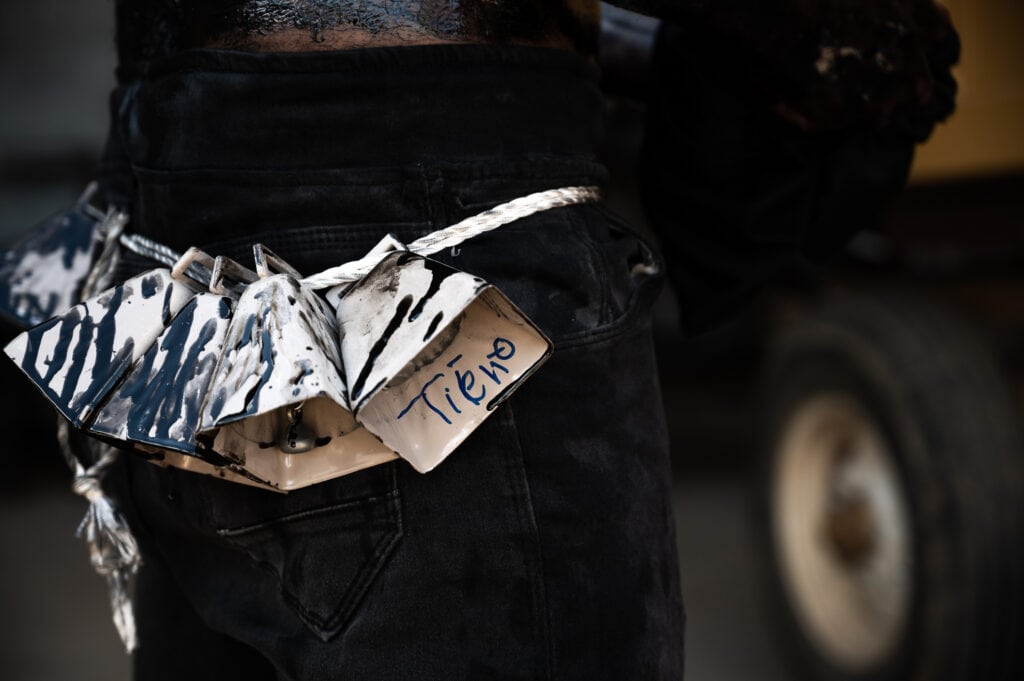
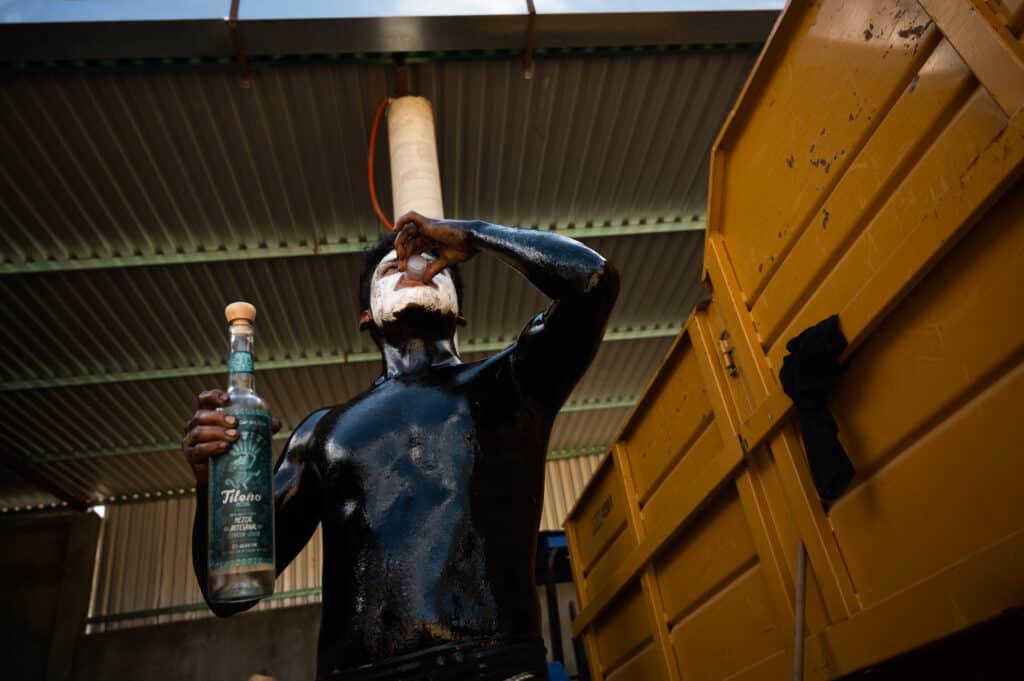
San Martin de Tilcajete
San Martin de Tilcajete is a small town an hour south of Oaxaca City. According to Elias, Tilcajete means place of ink. The word is divided into two parts; tilca means ink and cajete for the representation place.
The community is best known for the fantastical creatures. They are carved from copal wood and known as alebrijes. As you roam around the town you can find these amazing, brightly painted sculptures marking the entrance to family run workshops.
A prestigious workshop that has made its name both in and beyond Mexico, is that of ‘Maria y Jacobo’. Visiting their space you can find artisans working on every step of the process, from carving to painting and even adding gold leaf (a newer innovation). There is also a beautifully curated gallery space.
It was in this gallery that I first came across Mezcal Tileño. Elias is Jacobo’s brother. His palenque is about a ten minutes drive into the countryside, outside of Tilcajete. Unlike more mezcal focused communities, Tilcajete doesn’t allow production in the town itself due to the smoke.
Having tried Tileño Mezcal while visiting the gallery, I was keen to meet Elias. I was excited to understand more about how his passion for making mezcal entwines with his life in San Martin de Tilcajete where he is an active member of the community.
Tileño Mezcal
Elias describes mezcal as “a mixture of the 4 elements of nature, fire, water, earth and air that result in the inheritance of a liquid culture, which is made with the heart.” His mezcal is made using a pit oven, tahona and copper alembique. He learned his craft from his maternal grandfather.
Elias began to make his own mezcal in 2002. He says was driven by “the desire to return to the ancient craft of making mezcal that was born in me”. For over a decade he developed this craft, and in 2014 he registered the trademark for Tileño. Tileño refers to someone from Tilcajete.
In 2019 he began working with importer Tony Bagnulo of Broadcreek Spirits. They met through mutual friend and mezcal enthusiast Robert Sickler.
On deciding to make the plunge into the saturated agave spirits market, Bagnulo said: “The liquid is obviously amazing but Elias’s story, the culture and the personal side of it is as important to me as anything. His background as an artist comes through all of it.”
Since registering the brand, Elias has dedicated himself to the production of mezcal. “It has been a task that I have been perfecting with practice and time. Over time I have gained the experience to find the exact point, for example, at the time of distillation, which is what gives Tileño its special touch.”
Elias explains that this “special touch” is more to do with the hand and “essence” of the mezcalero. “According to our way of being, one puts one’s heart in each process and that makes it special and unique. I put all the dedication, all my time and effort so that each process is perfect. Only then can my mezcal have a quality that gives me satisfaction.”
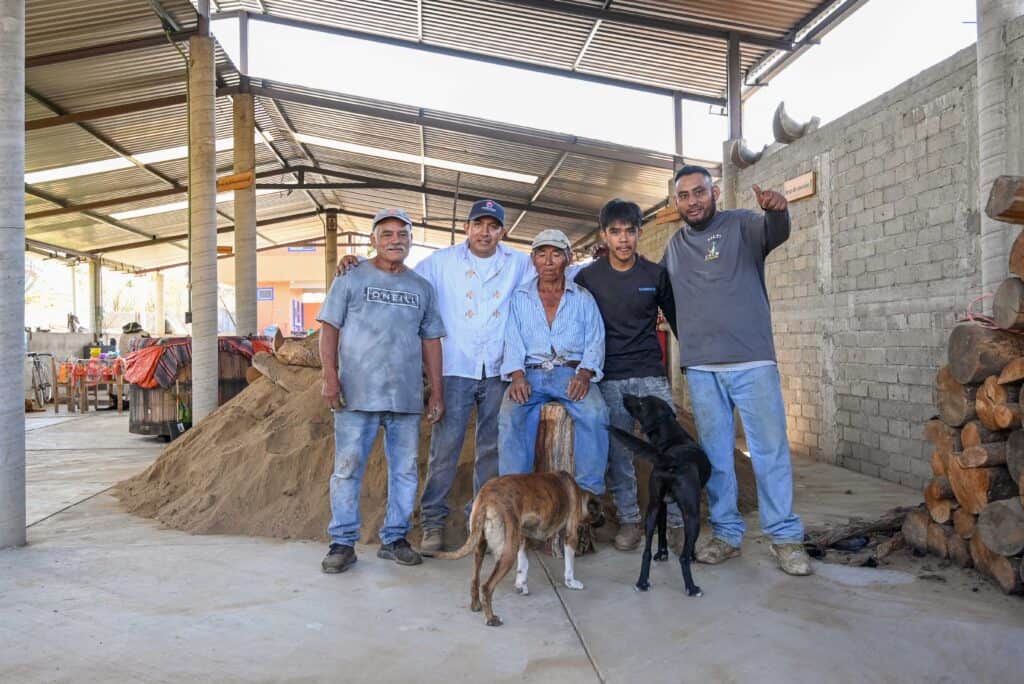
Agave and sustainable practices
The approach to the Tileño palenque is stunning. You come off the dusty road, into a lush looking, sloping field of agave. It’s a selection of different varieties of agave, trees and flowering plants such as roses and lavender. He uses waste elements of bagaso and viñaza to fertilize this garden.
He says he planted this field with thoughts for the future “Part of our project is to provide better spaces for pollinators such as bats, hummingbirds and bees that are a very important element for all agaves, also so that when someone visits us in the palenque they can appreciate some specimens of the agave varieties that exist.”
Elias also emphasized the importance of letting agave reach its maximum maturity before harvest. This is for sustainability reasons and quality of flavor. Although he is interested in domesticating wild agave, he has reservations about growing them in unfamiliar habitats. Like many mezcaleros, he works with a mixture of agave he buys and that he grows on his own property.
Maria y Jacobo have an initiative called Palo que Habla, which Elias also supports. They describe the project as a “multilateral initiative, which has the countryside as its central axis. Its diverse functions include defending, preserving and rehabilitating ecosystems in our community’s territory, harmonizing the traditional knowledge of the population with agricultural engineering and promoting a sustainable and fair way of life between nature and human beings.” They aim to generate microclimates and a solution to drought by building water reservoirs.
When I visited Elias at the palenque recently he was working with some water diviners, using a Y shaped stick to look for groundwater. He says that “with the drastic change in climate, water is scarce. Last year 2023 was very difficult because there was no rain.” The well would help them as a buffer against the drought. “Water is something essential in the lives of every human being and we need water for the entire mezcal process.”
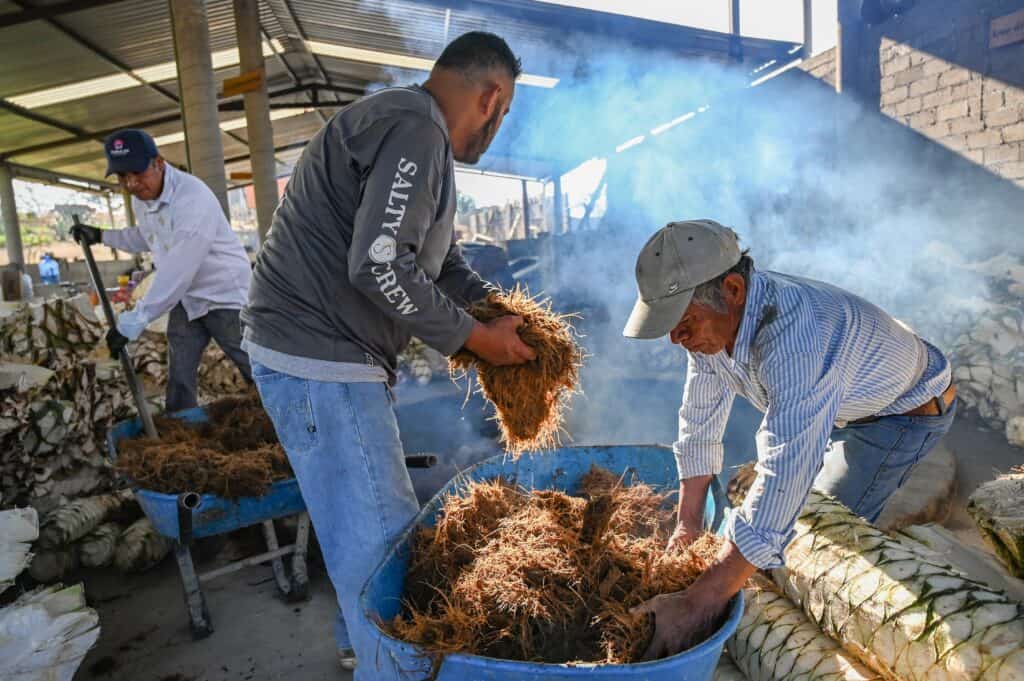

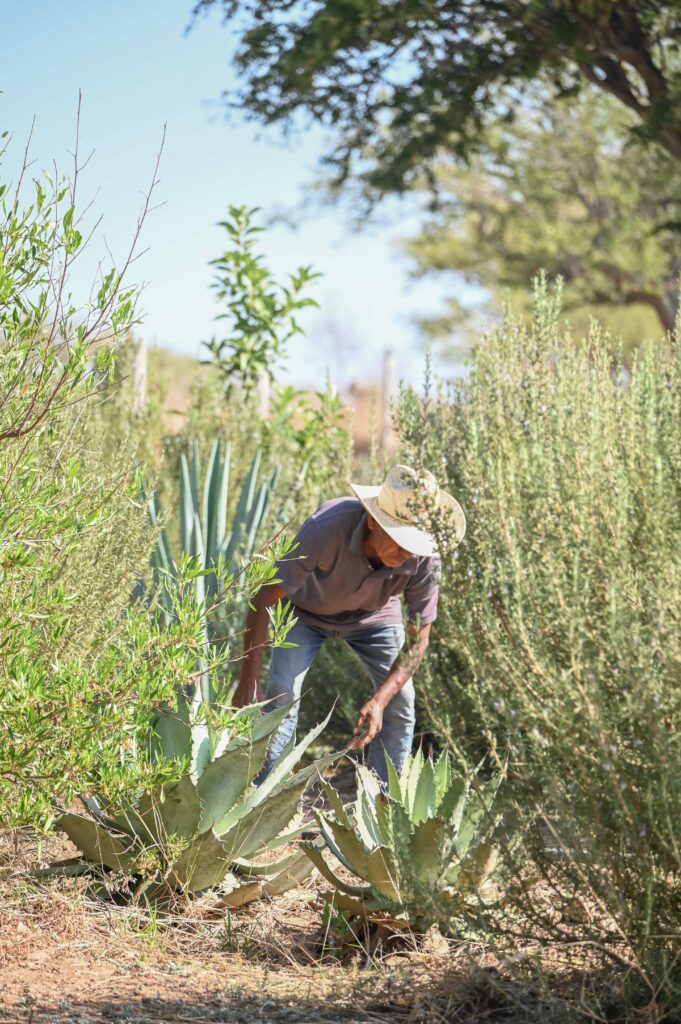
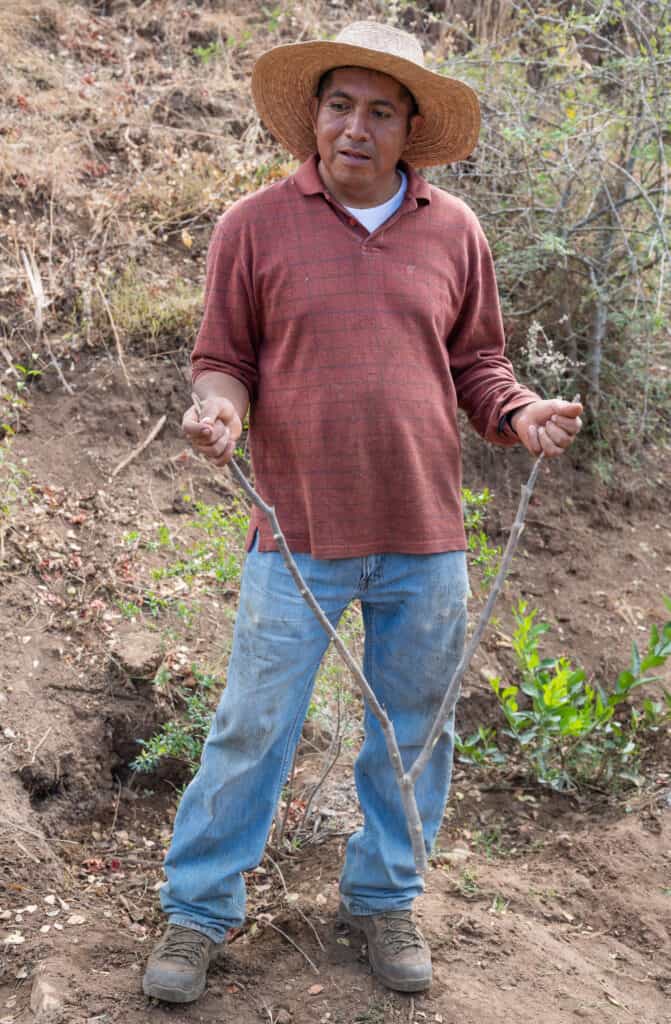
Community Support
Despite mezcal not being a typical practice in Tilcajete, Elias is grateful for a positive reception from his community. “Many of them are eager to learn about the production process and at the same time are consuming my products. Through my work, I believe people have learned to know what a quality mezcal is.”
Elias is also positive about the growing interest for visitors in San Martin de Tilcajete, specifically as it has helped raise awareness of his mezcal. “Thanks to the opening of tourism in this community many more people buy my product. They take it to their places of origin, which they then recommend to their acquaintances.” He feels this sort of promotion is important, because pitted against cheaper brands, they need that recognition of quality.
Although most of his relatives no longer work in the world of agave spirits, Elias says his family are essential support. “I believe that I would not be who I am without the support of my family, my wife, my children, they are my motivation and my strength.” He remembers that it was his uncle’s advice “to be a good hard-working person” that motivated him to “get ahead and achieve (his) dreams.”
The community of Tilcajete follows the tradition of “usos y costumbres,” the practice of indigenous customary law. Mexican governments recognize this local leadership and law with varying degrees of acceptance and formality.
Elias describes usos y costumbres as “certain responsibilities that as citizens we have to fulfill”. Men start off with being a “topil” (community policeman),then participating in different committees. The presidency is the highest degree you can aspire to.
He explains that “you have to participate in all ‘tequios.’ Tequio means ‘work or tribute’, an organized form of working towards a collective benefit. This work includes appointments in schools, health centers, street cleaning, putting out fires in the hills of the town, reforestation, etc. As well as cooperation for patron saint festivities or important community events.” By fulfilling your appointed roles you earn the respect of the community.
According to Elias, the most important thing about Tilcajete is the hospitality of its people. “We are a town rich in culture, crafts, traditions, we are people of work and a lot of partying too.” True to his word, Elias welcomed me into his palenque and home, where he shared his mezcal, artwork and invited me to participate in carnival celebrations.
Carnival Tradition
Elias remembers running through the streets with his brothers when he was young. “We met bigger oiled devils and they ran around us and screamed. We were scared because they were playing with us, hugging us and getting us dirty with their paint. But what mattered was going out to the carnival.”
Since pre hispanic times people from this region have been carving masks from copal, a sacred wood that grows in the area. Elias says that when the Spanish arrived, “our ancestors used these masks to howl at the conquerors.” They were seen as pagan ‘devils.’
Carnival is the celebration preceding the season of Lent, which in Catholicism is a time of reflection and repentance. According to Elias, Carnival is the opportunity to “have fun, dance, drink and reach the highest point of excess before repenting. The next day (Ash Wednesday) all those who went out to have fun at the carnival, have an obligation to go to the mass and mark their forehead with a cross of ashes as a sign of repentance and commitment to living a sin-free life.”
Although the root of carnival stays the same, some elements have changed with more visitors and specifically the participation of women.
Previously only men took part. “Since It was a party where you could get drunk and sometimes in the heat of the drinks there could be some fight or disturbance and it was dangerous for women.” Elias explains that it was also frowned upon by society as they felt women did not respect themselves if they took part, but he says “fortunately, people have changed their mentality.”
He explains that the carnival is the most anticipated party in the community. “It is a celebration that our ancestors left us. Every young person waits a year to bathe in oil again, tie their cowbells around their waists and go out into the streets to shout and let out their demons announcing that the carnival is coming. That fills us with celebration and joy and we Tileños, as they tell us, feel very proud of our carnival.”
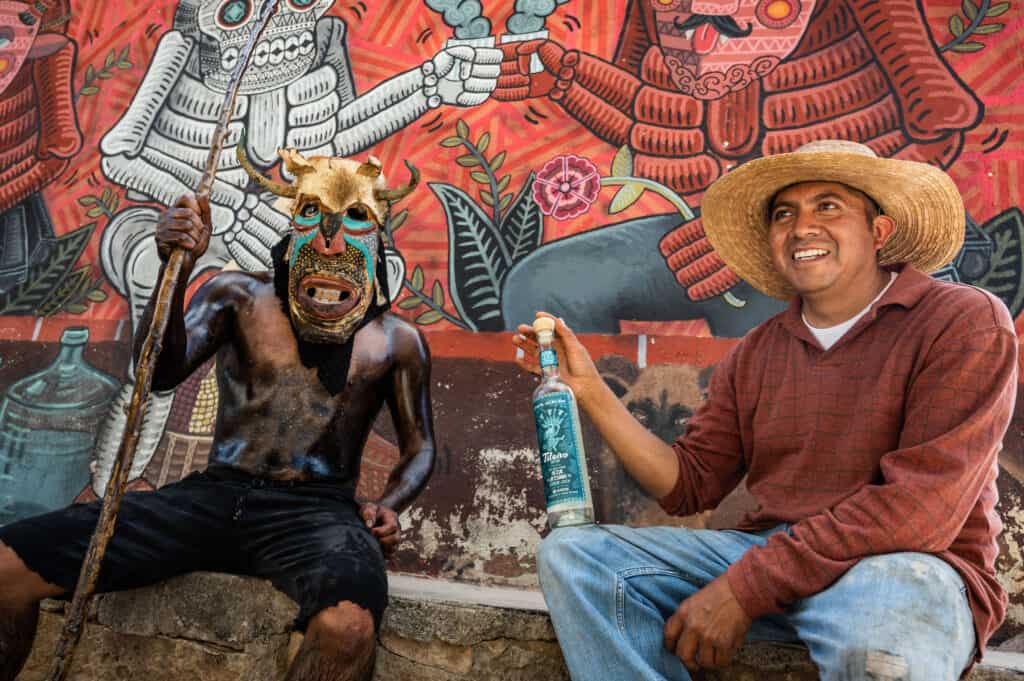
Elias the artist
Alongside his work as a mezcalero, Elias still makes alebrijes. “I was taught by my dad, he taught us how to carve ‘tonas’ or ‘nahuales’ today known as alebrijes.” Alebrijes are any animal or figure that is born from dreams or from imagination. Tonas and nahuales are spiritual animals governed by the Zapotec calendar. Usually you have two animals, one is a spiritual guide and one a protector.
Elias loves the design side of this work, which is further reflected in the label for Tilñno. “It is what I enjoy the most, playing with colors and giving life to the parts.”“The idea was initially to merge my two passions and professions in a bottle. The result was a bottle with Alebrije type designs but with Zapotec codices and meanings and obviously with a good mezcal inside.”
According to the Zapotec calendar Elias’s nahual is made up of the monkey and the deer, so it makes sense that the figure on the label is a monkey. In Zapotec culture, “the monkey is considered the great master of the arts, and making mezcal is an art.” The monkey is in a dancing position and in his hands a maguey “representing the joy that comes from the agave from which mezcal is obtained.”
Elias wanted each label to have a different color to represent the different agave expressions that he produces. For example the espadin is turquoise and the tobala expression is pink. These colors resonate with colors found in natural dyes such as indigo and cochineal used in the painting of alebrijes.
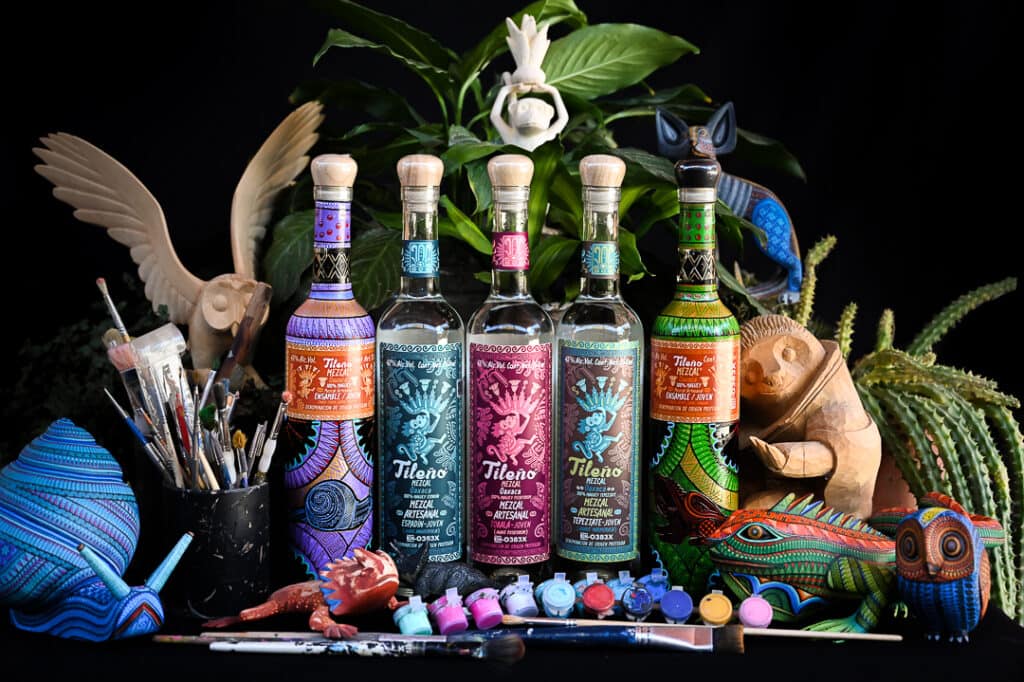
Alongside the decorative digital label, he and his wife also make beautiful hand-painted editions that look at home in the gallery of Maria y Jacobo and their location in Oaxaca City, Voces de Copal.
Although Ticajete is better known for the alebrijes and carnival than it is for mezcal, Elias has produced a delicious product that stands up to varieties from other regions of Oaxaca. He values certification, which he has maintained with the CRM, and enjoys every step of the process, from growing agave to palenque work and sales.
The next step is working with Bagnulo to get brand recognition in more states abroad. Their most recent step is into California.
Elias says that he dreams of being able to position Tileño as one of the best brands worldwide. “May Tileño be recognized for its quality and authentic flavor and tell the history and culture of its people.”
Hopefully the people visiting Tilcajete for carnival this year will have a chance to sip on Tileño mezcal, possibly arm in arm with an oiled up devil or two.

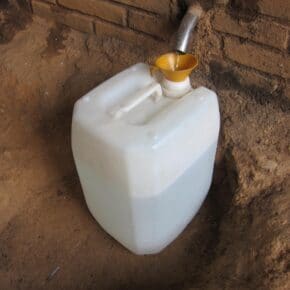
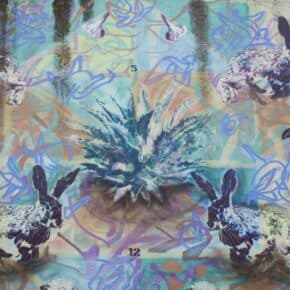









Leave a Comment